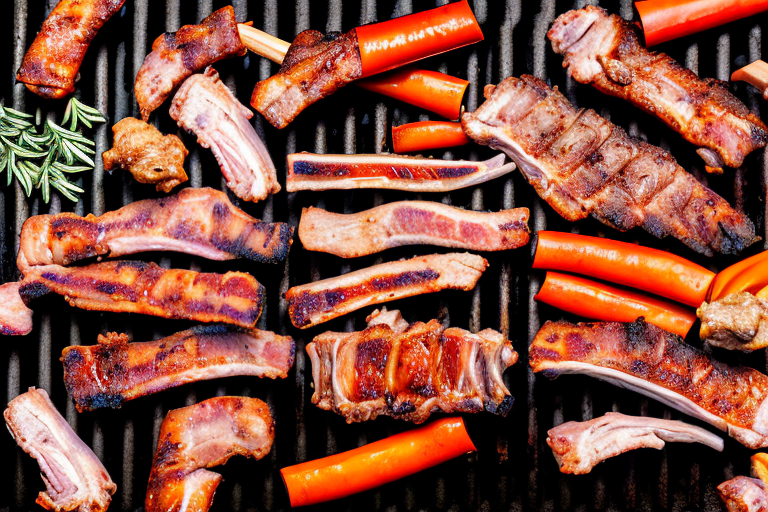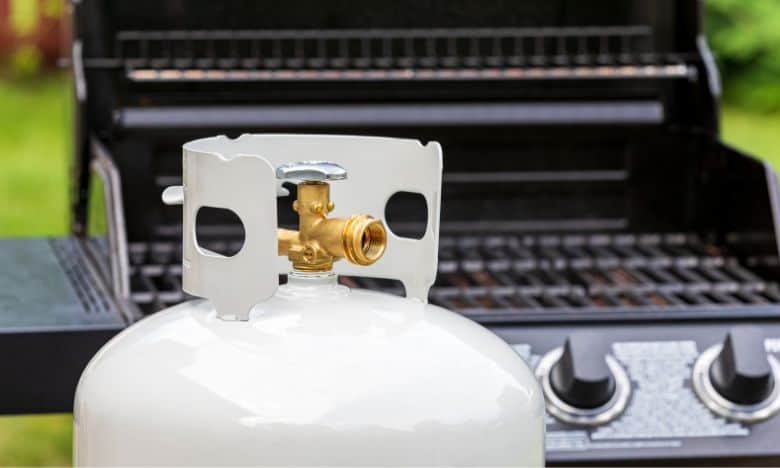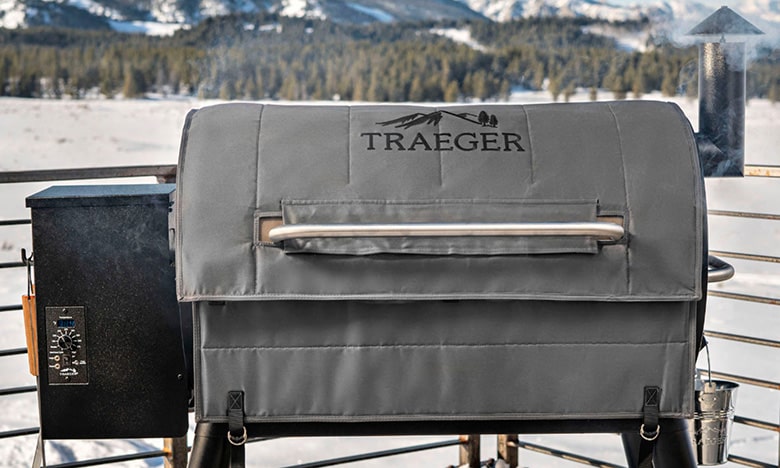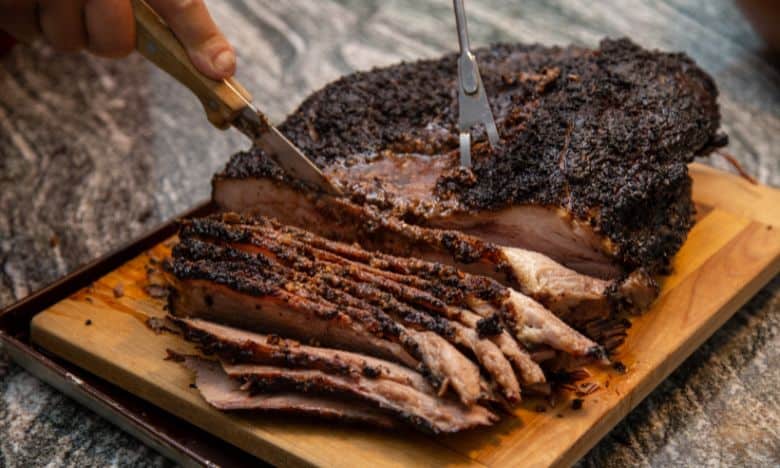Few cuts of meat are as satisfying to prepare and enjoy as pork riblets. This guide aims to take the mystery out of this often overlooked cut of meat while providing practical advice for selecting, storing, and preparing delicious pork riblets.
Table of Contents
What Are Riblets?
Before we delve into recipes and preparation methods, it’s essential to understand what exactly pork riblets are. The term can be a bit confusing, mainly because it is often mistakenly used for other cuts of meat.
Understanding the Cuts and Origins of Pork Riblets
The pork riblet is a small rectangular cut from the pig’s rib area. These pieces usually consist of the lower half of the rib bones, trimmed off when making spare ribs. This cut is rich in flavor and when cooked long and slow, it yields a tender and meaty dish.
But let’s take a closer look at the anatomy of the pig’s rib area. The ribs are located on the side of the pig’s body and extend from the spine to the sternum. Each rib is composed of bone and meat, with varying amounts of fat and connective tissue.
When it comes to pork riblets, the lower half of the rib bones is utilized. These bones are shorter and smaller in size compared to the upper half, making them more manageable for cooking and eating. The meat attached to the rib bones is marbled with fat, adding flavor and moisture to the dish.
Understanding the Difference Between Pork Riblets and Rib Tips
There’s often confusion between riblets and another cut of meat called rib tips. Rib tips, while similar, come from the ends of spare ribs. They have a larger bone and often more cartilage. Riblets, on the other hand, are smaller and easier to eat, making them perfect for appetizers or snacks.
When it comes to texture, riblets tend to be more tender compared to rib tips. The smaller size of riblets allows for more even cooking, resulting in a melt-in-your-mouth experience. Rib tips, with their larger bone and cartilage, require longer cooking times to achieve the desired tenderness.
Both riblets and rib tips offer unique flavor profiles. The meat surrounding the bones in riblets is succulent and moist, while rib tips have a slightly chewier texture. The choice between the two ultimately depends on personal preference and the desired cooking method.
Exploring the Flavor Profile of Pork Riblets
Pork riblets have a distinct flavor profile. They are naturally rich in taste, with the bone contributing to the overall aroma of the meat when cooked. When marinated and slow-cooked, they have a satisfyingly delicious and tender texture that meat lovers can’t resist.
But what gives pork riblets their unique flavor? The answer lies in the combination of factors. First, the marbling of fat throughout the meat adds richness and moisture. As the riblets cook, the fat slowly renders, infusing the meat with its savory goodness.
Additionally, the bone itself plays a crucial role in enhancing the flavor. Bones are known to contain marrow, a fatty and nutrient-rich substance that adds depth and complexity to the meat. When cooked slowly, the marrow melts and becomes part of the sauce or glaze, intensifying the overall taste experience.
Furthermore, the cooking method used for pork riblets greatly affects their flavor. Whether you choose to grill, bake, or braise them, each technique brings out different nuances in the meat. Grilling can create a smoky and charred exterior, while baking allows for a caramelized glaze to develop. Braising, on the other hand, results in tender and succulent riblets that have absorbed the flavors of the cooking liquid.
In conclusion, pork riblets are a flavorful and versatile cut of meat. Their small size and rich taste make them ideal for various cooking methods, from grilling to slow-cooking. Whether enjoyed as an appetizer, a snack, or a main course, pork riblets are sure to satisfy meat lovers with their tender texture and delicious flavor.
Your Guide to Buying the Best Pork Riblets
Buying riblets can be a challenging endeavor, especially if you don’t know what to look for. Here are a few tips to help you purchase fresh and high-quality pork riblets.
Tips for Selecting Fresh and High-Quality Pork Riblets
To ensure the riblets you buy are fresh and of high quality, keep an eye on the meat’s color. It should be a fresh, reddish-pink hue, and the fat – which should be firm – should be white. Avoid any riblets with a dull color or any that have a strong odor. Fresh pork should have a mild and clean smell.
When selecting pork riblets, it’s important to consider the marbling. Marbling refers to the thin streaks of fat that run through the meat. A good amount of marbling is desirable as it contributes to the tenderness and flavor of the riblets. However, be cautious of excessive marbling as it can make the meat greasy and overpower the taste.
Another factor to consider is the thickness of the riblets. Thicker riblets tend to be juicier and more flavorful. Look for riblets that are at least 1 inch thick to ensure a satisfying eating experience. Thin riblets may dry out quickly during cooking and result in a less enjoyable meal.
When examining the packaging, check for any signs of leakage or damage. Airtight packaging is crucial to maintaining the freshness of the riblets. Avoid packages with punctures or tears, as they may indicate mishandling or improper storage.
It’s also worth considering the source of the pork riblets. Look for riblets that come from reputable suppliers or local farms that prioritize animal welfare and sustainable farming practices. Supporting ethical and sustainable food production not only ensures a better quality product but also contributes to a healthier environment.
Before making your final decision, take a moment to assess the overall appearance of the riblets. They should have a well-trimmed appearance with minimal excess fat or bone fragments. This will make the cooking process easier and ensure a more enjoyable dining experience.
Lastly, don’t be afraid to ask your butcher for recommendations or advice. They are knowledgeable about different cuts of meat and can provide valuable insights to help you make an informed choice. Building a good relationship with your local butcher can lead to a more personalized and enjoyable shopping experience.
Properly Storing Pork Riblets for Maximum Freshness
Now that you have your fresh pork riblets, the next dilemma is how to store them properly to maintain their freshness. Pork riblets, just like any other meat cut, require careful handling and storage.
Best Practices for Keeping Pork Riblets Fresh in the Refrigerator
When it comes to storing pork riblets, following best practices is essential to ensure their maximum freshness. One of the most important steps is to store the riblets in a shallow, air-tight container or a resealable plastic bag. This will help prevent any exposure to air, which can lead to the meat losing its freshness and succulence.
It is also crucial to place the riblets in the coldest part of your refrigerator. This area typically maintains a temperature between 32°F (0°C) and 40°F (4°C), which is ideal for keeping meat fresh. By storing the riblets in this section, you are minimizing the risk of bacterial growth and ensuring their longevity.
Additionally, it is recommended to use the pork riblets within three to five days of purchase. This timeframe allows you to enjoy the meat at its peak freshness and flavor. However, if you plan on keeping the riblets for a longer period, freezing is an excellent option.
Freezing the riblets not only extends their shelf life but also helps lock in their natural juices and flavors. Before freezing, it is advisable to wrap the riblets tightly in plastic wrap or aluminum foil to prevent freezer burn. Then, place them in a freezer-safe bag or container, ensuring they are properly sealed to avoid any exposure to air or potential cross-contamination.
When properly stored in the freezer, pork riblets can be kept for about six months. It is important to note that the quality of the meat may gradually deteriorate over time, so it is best to consume them within this recommended timeframe for optimal taste and texture.
By following these best practices for storing pork riblets, you can ensure that they maintain their maximum freshness and quality, allowing you to enjoy delicious meals whenever you desire.
Delicious Ways to Prepare Pork Riblets
The preparation method can significantly impact the final outcome of your pork riblets. Whether you prefer to grill, bake, or smoke them, there’s a recipe out there that will tantalize your taste buds.
When it comes to grilling pork riblets, the smoky flavor that permeates the meat is simply irresistible. Imagine the sizzle of the hot grill as you carefully place the riblets on the grates, their tantalizing aroma wafting through the air. The heat of the flames sears the outside, creating a beautiful caramelized crust while locking in the natural juices. As you flip the riblets, the sizzling continues, and you can almost taste the mouthwatering tenderness that awaits.
If you prefer baking your pork riblets, you’ll be rewarded with succulent and juicy meat that practically falls off the bone. Picture yourself preheating the oven, the anticipation building as the delicious aroma fills your kitchen. As the riblets slowly roast, the fat renders and bastes the meat, resulting in a tender and flavorful dish. The low and slow cooking method allows the flavors to meld together, creating a delightful symphony of taste with every bite.
For those who enjoy a more intense and robust flavor, smoking pork riblets is the way to go. The process of smoking infuses the meat with a smoky essence that adds depth and complexity to every mouthful. Imagine the tantalizing scent of hickory or mesquite wood chips as they slowly burn, enveloping the riblets in a cloud of aromatic goodness. The low temperature and extended cooking time allow the flavors to develop slowly, resulting in a dish that is rich, tender, and utterly delicious.
Mouthwatering Pork Riblet Recipes to Try
Some of the most popular pork riblet recipes include honey-glazed smoked riblets, barbecued riblets with a tangy sauce, or grilled riblets with a spicy rub. These options capitalize on the riblets’ natural taste and employ various cooking techniques to enhance their flavor.
Imagine sinking your teeth into a honey-glazed smoked riblet. The sweet and sticky glaze caramelizes on the outside, creating a beautiful crust that adds a delightful crunch to each bite. The smokiness from the wood chips permeates the meat, enhancing its natural flavors and creating a harmonious balance of sweet and savory.
Or how about sinking your teeth into a barbecued riblet with a tangy sauce? Picture yourself slathering the riblets with a homemade barbecue sauce, made with a blend of tangy vinegar, sweet molasses, and a touch of heat. As the riblets cook on the grill, the sauce caramelizes, creating a sticky and finger-licking glaze that coats the meat. The combination of flavors is simply irresistible.
If you prefer a bit of heat, try grilled riblets with a spicy rub. Imagine coating the riblets with a mixture of spices like paprika, cayenne pepper, garlic powder, and brown sugar. As the riblets grill, the spices create a flavorful crust that adds a kick to each bite. The heat slowly builds, tantalizing your taste buds and leaving you craving more.
Elevating Your BBQ Game with Smoked Pork Riblets
Are you looking to elevate your barbecue game? Then smoked pork riblets are your answer. Done correctly, they can be an irresistible crowd-pleaser at any gathering.
Essential Ingredients for Flavorful Smoked Pork Riblets
The secret to delicious smoked pork riblets lies in the quality of the ingredients used. Key ingredients include quality riblets, your favorite BBQ rub, apple juice for spritzing, BBQ sauce, and hardwood chunks for smoking.
Step-by-Step Instructions for Smoking Perfect Pork Riblets
The process of smoking riblets is fairly straightforward and involves preparing the pork riblets, applying the dry rub, smoking the riblets for a couple of hours, glazing with barbecue sauce, and smoking for an additional short period. The result? Deliciously soft riblets with a smoky aroma and tantalizing flavor.
In conclusion, whether you’re a seasoned BBQ master or a home cook looking to explore new cuts of meat, pork riblets are an excellent choice. Armed with this guide, you’re now ready to enjoy deliciously smoked pork riblets that your family and friends will love. Bon Appétit!






